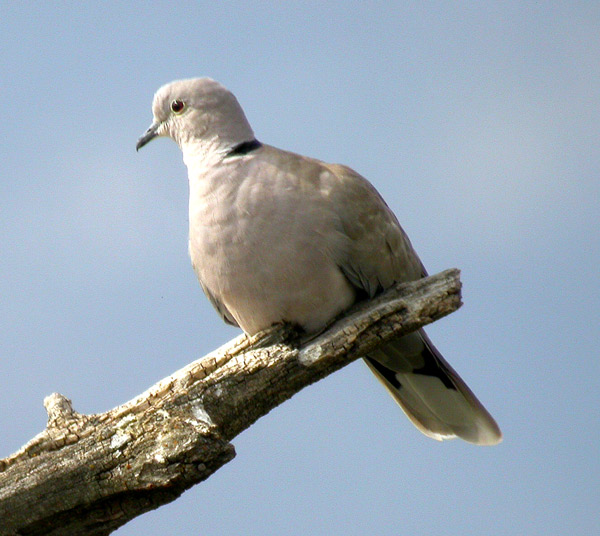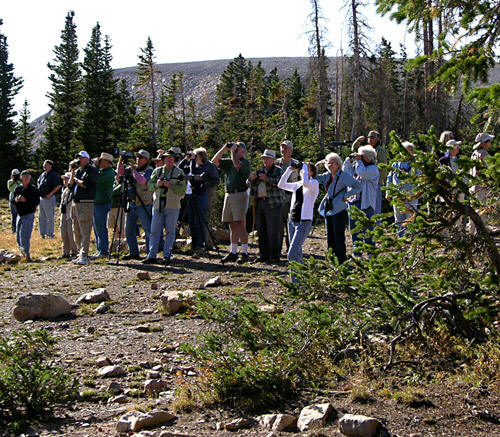Utah County Birders Newsletter
|
 |
|
photo by Milt Moody |
Eurasian Collard-Dove
Bubulcus ibis
by Tuula Rose
If prizes were given in the bird world for taking over continents, the Eurasian
Collared-Dove would win the “Expansionist Award”, beating the starling, the
English sparrow and even the cattle egret wings down. A hundred years ago this
species was found mainly on the Indian subcontinent with its range extending
slightly into Europe in Turkey. In the early 1900s it started expanding its
range into Europe reaching the British Isles by 1950. Today they are found above
the Arctic Circle in Scandinavia. According to my Finnish bird guide they
arrived in 1955 and now there are several hundred nesting there even reaching
the far north. Interestingly, the Finns call this bird the Turkish Dove.
On this continent, the saga is even more amazing. Eurasian Collared-Doves were
introduced (for whatever reason!) into the Bahamas in the 1970s and they soon
spread out on the islands. What happened next is unclear. Somehow they migrated,
without assistance, from the Bahamas to Florida, where they started expanding
unnoticed because they resemble the Ringed Turtle-Dove. In the mid-1980s
ornithologists realized that the suddenly prolific and quickly spreading “turtle
doves” they were watching were actually Eurasian Collared-Doves.
The Ringed Turtle-Dove has been a popular cage bird and escapees have
established small populations in Florida, California and a few other southern
states. These two doves look very much alike. They are uniformly pale brown, and
both have a black collar on the back of the neck. The RTD is smaller and has a
white belly and undertail coverts, while the ECD shows a darker grayer belly and
undertail, also showing more black at the base of the tail. Their songs are
quite different. The collared-dove’s song is a coarse rapidly delivered
three-part cooing while the turtle dove has a hollow rolling two-part song.
Since neither of these doves migrates, there were no strays or accidentals to
watch for from Europe. Our popular field guides never even listed or showed
pictures of the Eurasian Collared-Dove before the eighties. The 1983 edition of
the National Geographic Field Guide mentions the ECD in passing when describing
the RTD. The first picture I found among my field guides is in the 1997 edition
of All the Birds of North America. Even the 1990 3rd edition of Peterson Field
Guide does not have a picture.
The very first report of ECD in Utah was by Rob Fergus and Matt DeVries in Orem
in the summer of 1997. In 2000 this dove was seen at Fish Springs, of all
places, and an official sight report to the Records Committee was made by Taylor
Hicks. In September of 2001 Dana Green and others from Salt Lake were at River
Lane by Utah Lake and identified a Eurasian Collared-Dove. Several doves were
seen around a farm house at River Lane during that and the following year. They
were thought to be domesticated doves after someone asked the farmer who claimed
them to be his doves! Only after several reports came in from all around the
state did we realize that the ECD was indeed a wild bird taking over our state
and the entire continent. Experts are saying that only time will tell how the
spread of this non-native species is going to effect the populations of native
doves and pigeons. They also fear that it might become a pest for seed crops. It
is interesting to see this amazing spread on maps generated by The Great
Backyard Bird Count. Go to http://www.birdsource.org/gbbc/ and select:
Explore the results and Maproom to see the maps for several years and
the multi-year animation.
Both sexes of the Eurasian Collared-Dove are similar. They are usually solitary
or in pairs. The nest is made of twigs, stems, roots and grasses, and placed in
trees. The clutch is two white slightly glossy eggs. A pair can raise several
broods in a breeding season.
Interesting facts about pigeons and doves in general:
1. Since they eat mainly dry seeds and grains, their need for water is greater
than that of birds who feed on insects, worms, grubs or fruit. They drink up to
15% of their body weight per day. Unlike any other North American birds, they
are able to suction water into the throat without raising the head. Other birds
have to scoop water into the bill and tip the head up to let water run down the
throat.
2. Both the female and the male are able to produce a substance called “Pigeon
milk” or “Crop milk”. It is secreted by the lining of the crop and fed to chicks
for 5 to 10 days after hatching before being fed on regurgitated seeds. Rich in
fats and proteins, the crop milk meets the nutritional needs of young chicks in
the same way that insects and animal protein sustain the young of most other
bird species.
References:
-Articles on www.Birdsource.org by John Schmitt and Wesley M. Hochachka.
-The Sibley Guide to Bird Life and Behavior by David Allen Sibley.
-Rare Bird Sightings – Comprehensive List on
www.utahbirds.org
Field Trip Report
Mirror Lake Highway - 25th August 2007
by Lu Giddings
 |
|
Utah County Birders, Salt Lake Birders
and Great Salt Lake Audubon members at Bald Mountain - 25 Aug 2007
|
Several car-loads of birders left Provo at 6:30 a.m. We stopped along the way
at the inlet end of Deer Creek reservoir, which is remarkably low, and saw a
variety of birds including sandhill cranes and an osprey.
A group of roughly 35 birders left the Kamas Ranger station at 8 a.m. It was our
intent to find several target species: black rosy-finches, American three-toed
woodpeckers, pine grosbeaks, and gray jays.
We first stopped at Bald Mountain Trail Head to look for Rosy-finches and were
disappointed, but pine grosbeaks, pine siskins, and a northern flicker were
seen, amongst other things.
At Mirror Lake we divided into three groups of roughly ten birders each. One
group circumnavigated the lake while two groups went into the campgrounds and a
fourth, smaller group explored by car. Bird numbers were markedly lower than
roughly a month ago, but a number of interesting birds were still seen. A few
people had the good fortune to see an American three-toed woodpecker. Most - if
not all - of the group saw gray jays and Clark's Nutcrackers.
We made a final stop at Trial Lake, making one final attempt to find American
three-toed woodpeckers. We managed to find a hairy woodpecker and a mystery
empid, and Steve Carr spotted two more gray jays in an empty campground.
The weather was warm, clear, and a bit breezy but mostly beautiful. It's hard to
believe that snow will be on the ground in just a few weeks, but the birds know
and are preparing themselves.
Many thanks to all of you, both Salt Lake birders and Utah county birders, for
your support of this activity. A partial trip list may be found below. And a big
thanks(!) to Craig Fosdick and Mark Stackhouse for supplying the information
that helped make the trip a success.
Lu Giddings
Total Count: 26
Common Merganser, American White Pelican, Osprey, American Coot, Sandhill Crane,
Eurasian Collared-Dove, Mourning Dove, White-throated Swift, Hairy Woodpecker,
Northern Flicker, Gray Jay, Black-billed Magpie, Common Raven, Mountain
Chickadee, Red-breasted Nuthatch, American Robin, European Starling,
Yellow-rumped Warbler, Chipping Sparrow, Vesper Sparrow, White-crowned Sparrow,
Dark-eyed Junco, Red-winged Blackbird, Pine Grosbeak, Pine Siskin,
House Sparrow.
Backyard Bird of the
Month
August 2007
Fred Baker - Provo
Quail, family of 8 - Black headed grosbeaks - Finches-lots-sparrows, etc -
Mourning doves - Chickadees & nuthatchs, rare Black chinned hummingbirds.
Steve Carr - Holladay
Rufous Hummingbird - Daily for a couple of weeks.
Eric Huish - Pleasant Grove
Cassin's Finch
Milt Moody - Provo
Red-breasted Nuthatch - haven't seen one for a while.
LeIla Ogden - Orem
Black capped chickadees.... Every day visitors. Very friendly.
Cheryl Peterson - Provo
Male Western Tanager
Bruce Robinson - West Jordan
Rufous Hummingbird - But it means summer is almost over!
Reed Stone - Provo
Two Belted Kingfishers circling over my backyard trees, yes siree.
We would like you to share your favorite backyard bird each
month. Please send your favorite bird at the end of the month to
newsletter@utahbirds.org or call 360-8777. If you would like a reminder at
the end of the month e-mail the above address.